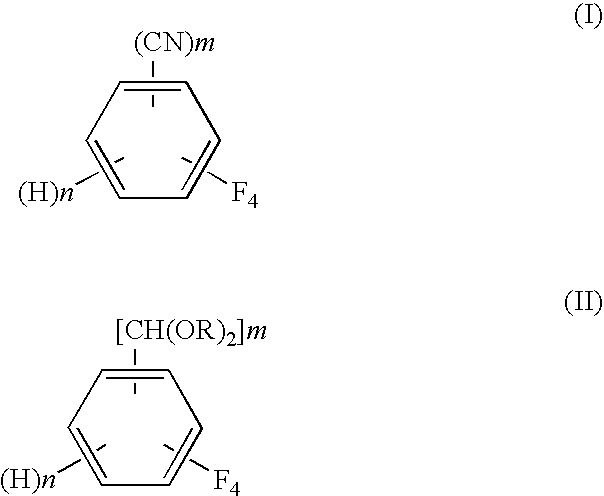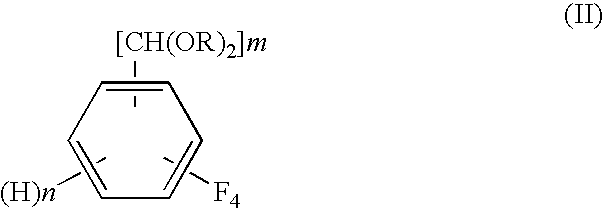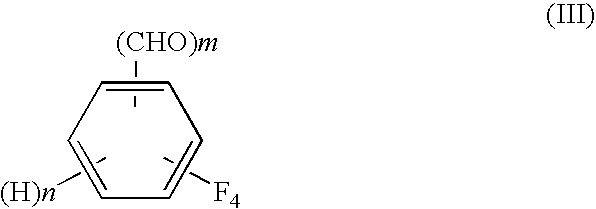Process for preparing tetrafluorobenzene carbaldehyde alkyl acetal
a technology of tetrafluorobenzene and alkyl acetal, which is applied in the preparation of carbonyl compound by hydrolysis, carbonyl compound preparation, organic chemistry, etc., can solve the problems of inability to reuse catalyst thus dissolved and low reaction yield, and achieves the effect of reducing the burden on equipment for further isolation and purification and high efficiency
- Summary
- Abstract
- Description
- Claims
- Application Information
AI Technical Summary
Benefits of technology
Problems solved by technology
Method used
Image
Examples
example 1
[0061]In a conical flask, 20.6 g of 95% sulfuric acid was slowly added dropwise to 70 g (2.2 mol) of methanol with ice cooling. Then, into a 300-ml glass autoclave, the resulting sulfuric acid / methanol solution and a 5% Rh / C catalyst (available from NE Chemcat Corporation, hydrous product) in an amount of 0.25 g on a dry weight basis were charged. The system was purged with hydrogen to make a hydrogen pressure 0.1 MPa at room temperature. Heating of the autoclave and stirring of the contents in the autoclave were started, and the temperature was increased to 40° C. and was held constant for 1 hour. After the autoclave was cooled, 10 g (50 mmol) of tetrafluoroterephthalonitrile (available from Tokyo Kasei Kogyo Co., Ltd.) was fed to the autoclave, and the temperature was raised to 70° C. in a nitrogen atmosphere. At 70° C., introduction of hydrogen was started. The reaction pressure was controlled so that the hydrogen absorption rate should become not more than 10 ml / min. After a lap...
example 3
[0065]The same operations as in Example 1 were carried out, except that the temperature of the pretreatment of the catalyst with hydrogen was changed from 40° C. to 50° C. After a lapse of 5.5 hours, absorption of hydrogen ceased. The quantity of hydrogen absorbed was 106% of the theoretical quantity of hydrogen absorbed. Treatment of the reaction solution was carried out in the same manner as in Example 1.
[0066]From the toluene extract, a small amount of a sample was withdrawn, and it was subjected to GC analysis. As a result of the analysis, a peak of the tetrafluoroterephthalonitrile as a raw material was below the detection limit, the amount of tetrafluoroterephthalaldehyde was 89.4 mol %, the amount of 2,3,5,6-tetrafluorobenzene was 1.31 mol %, and the amount of 2,3,5,6-tetrafluorobenzonitrile was 1.03 mol %. On the other hand, the aqueous phase was neutralized and then subjected to GC analysis. As a result of the analysis, presence of 2.35 mol % of 2,3,5,6-tetrafluorobenzylami...
example 4
[0067]The same Operations as in Example 1 were carried out, except that the reaction temperature was changed from 70° C. to 80° C. After a lapse of 5.5 hours, absorption of hydrogen ceased. The quantity of hydrogen absorbed was 99% of the theoretical quantity of hydrogen absorbed. Treatment of the reaction solution was carried out in the same manner as in Example 1.
[0068]From the toluene extract, a small amount of a sample was withdrawn, and it was subjected to GC analysis. As a result of the analysis, a peak of the tetrafluoroterephthalonitrile as a raw material was below the detection limit, the amount of tetrafluoroterephthalaldehyde was 87.5 mol %, the amount of 2,3,5,6-tetrafluorobenzene was 2.00 mol %, and the amount of 2,3,5,6-tetrafluorobenzonitrile was 1.61 mol %. On the other hand, the aqueous phase was neutralized and then subjected to GC analysis. As a result of the analysis, presence of 2.16 mol % of 2,3,5,6-tetrafluorobenzylamine was confirmed. The results are set fort...
PUM
| Property | Measurement | Unit |
|---|---|---|
| temperature | aaaaa | aaaaa |
| pressure | aaaaa | aaaaa |
| temperature | aaaaa | aaaaa |
Abstract
Description
Claims
Application Information
 Login to View More
Login to View More - R&D
- Intellectual Property
- Life Sciences
- Materials
- Tech Scout
- Unparalleled Data Quality
- Higher Quality Content
- 60% Fewer Hallucinations
Browse by: Latest US Patents, China's latest patents, Technical Efficacy Thesaurus, Application Domain, Technology Topic, Popular Technical Reports.
© 2025 PatSnap. All rights reserved.Legal|Privacy policy|Modern Slavery Act Transparency Statement|Sitemap|About US| Contact US: help@patsnap.com



